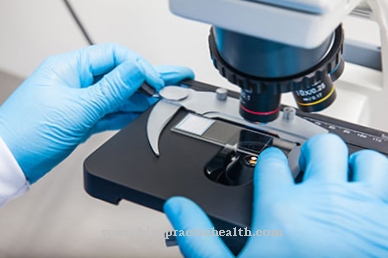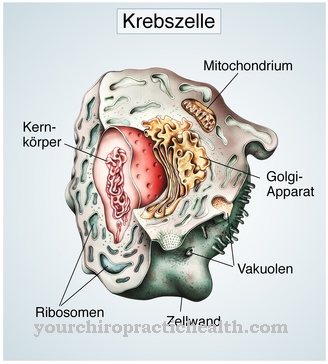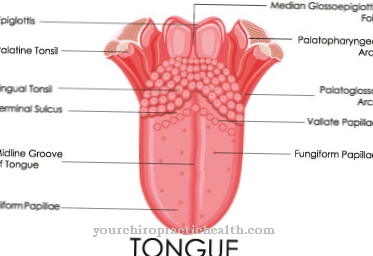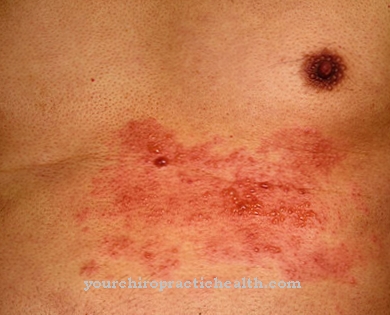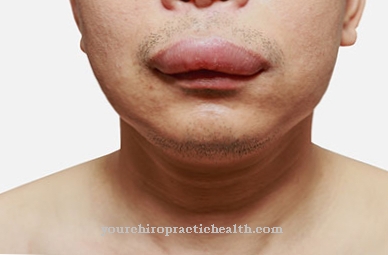A Common bile duct cyst is a cyst-like enlargement of the biliary tract. Its cause is largely unknown. Early treatment is necessary due to later complications.
What is a common bile duct cyst?

© Henrie - stock.adobe.com
The common bile duct cyst manifests itself in a cyst-like expansion of the biliary tract. The biliary tract is a canal-like structure that transports the bile from the liver into the duodenum. There are intrahepatic and extrahepatic biliary tracts. While intrahepatic bile ducts are located inside the liver, the extrahepatic bile ducts represent the transport of bile outside the liver. In the broadest sense, this also includes the gallbladder.
A common bile duct cyst describes the extrahepatic enlargement in the bile ducts between the liver and duodenum. The cystic enlargements can come in different forms. There may be localized or diffuse enlargements of the bile duct. But there are also diverticulum-like cysts. These consist of bulges in the common bile wall. Some cystic pouches protrude into the duodenum. The entire common bile duct can also be dilated.
Usually the cysts have existed since birth. Often they are only discovered by chance. But there are also cases in which the cysts only develop over time. Overall, common bile duct cysts are very rare. The probability of their occurrence is between 1: 50,000 and 1: 150,000. A common bile duct cyst always harbors the risk of complications.
causes
The causes of a common bile duct cyst are largely unknown. Since the cyst has usually existed since early childhood, a genetic cause is suspected. It is said to be autosomal recessive malformations. Secondary reasons for the formation of cysts are also discussed. For example, due to a malformation of the excretory duct of the pancreas, in rare exceptional cases it should form a common duct with the bile duct for a short distance.
The digestive enzymes of the pancreas partially flow through this common connection into the common bile duct. This leads to self-digestion of the bile duct walls. Due to the resulting weakness of the bile duct walls, they are no longer able to withstand the pressure of the biliary fluid that builds up. As a result, they expand like cysts. However, this explanation is only based on assumptions that have yet to be proven. However, the cysts appear to be due to congenital malformations that are not uniform.
Symptoms, ailments & signs
Depending on the extent of the common bile duct cyst, either no symptoms occur or abdominal pain, yellowing of the skin and light-colored stools occur in early childhood. The bile becomes blocked so that it can get into the blood. A post-hepatic jaundice develops. When the yellow pigment bilirubin escapes from the blood into the body organs, the skin turns yellow.
The bile pigment no longer gets into the intestines, so the stools look light. Since the dietary fats can no longer be emulsified by the bile, they are excreted with the stool in the form of so-called fatty stools. Patients also suffer from constant flatulence because the digestive enzymes in the pancreas no longer work effectively.
If the common bile duct cyst has existed for a long time, there is a risk of recurrent gallstones, bilious [peritonitis]] or cholangiocarcinoma. Peritonitis can be caused by a rupture of the weakened walls of the bile duct. The action of the digestive juices of the pancreas also causes chronic inflammatory processes that increase the risk of carcinoma.
diagnosis
A common bile duct cyst is often found incidentally in sonographic examinations during pregnancy. However, the cysts are usually noticeable after pregnancy. Here, too, there are either incidental findings in the context of a sonography or examination results of a detailed examination in the case of chronic abdominal complaints in children with jaundice. Magnetic resonance imaging or endoscopy can also be performed to clarify the diagnosis.
Complications
The complications that can occur as a result of a common bile duct cyst vary widely. In most cases, there will be relatively strong stomach jokes and jaundice. The stool is also yellowish and light in color. The patient's quality of life is greatly reduced due to the persistent abdominal pain.
Even hard physical work is hardly possible due to the pain. The patient also suffers from severe flatulence, which can have a negative effect on social contacts and also on the patient's self-esteem. Often gallstones or inflammation in the pancreas develop. If the common bile duct cyst is not treated properly and early, life expectancy will usually be reduced.
In many cases, the common bile duct cyst occurs again in the patient even after treatment and must therefore be removed again. The treatment itself aims to completely remove the cyst. The removal is carried out using a surgical procedure.
Certain inflammations before and after the operation can lead to complications. If the common bile duct cyst is diagnosed in children and removed immediately, there are usually no restrictions on physical and psychological development.
When should you go to the doctor?
If the child complains of abdominal pain and problems with bowel movements, this is a reason for a doctor's visit. If the characteristic yellow coloration of the skin is noticed, it is best to go to the nearest hospital directly.
Gallstones and symptoms of peritonitis suggest that the common bile duct cyst has been around for a long time. Corresponding complaints should therefore be medically clarified immediately. If the cyst is left untreated, there is a risk of biliary cancer - a medical emergency that needs to be treated in the clinic.
If a pancreatitis or a rupture has already developed, a doctor must also be consulted immediately. A common bile duct cyst usually has genetic causes. In the best case scenario, a physical examination is carried out during childhood to reveal the disease.
Diseases of the pancreas and gallbladder are suspected of promoting the development of a common bile duct cyst. Anyone who has been or is affected by such a condition should speak to their family doctor if they have symptoms mentioned. Other contact persons are the gastroenterologist or a specialist in internal medicine.
Doctors & therapists in your area
Treatment & Therapy
Due to the manifold complications of the common bile duct cyst, early therapy is essential. Studies have shown that a rupture can occur in 20 percent of all cases. Another 30 percent of patients develop pancreatitis. In addition, the risk of malignant degeneration is very high. At the age of 30 to 35, 20 to 30 percent of those affected develop choledochal cyst carcinoma.
In the past, continuous cyst drainage was performed, but this is no longer recommended due to the complications that occur. The most important goal of therapy today is the complete removal of the cyst. The pancreatic duct must be spared. The operation should be carried out as early as possible because the risk of operational risks increases with age. Every inflammatory process contributes to increasing the risk of surgery later on.
The operation can be carried out openly as well as minimally invasive. During the operation, the dilated bile ducts are removed and the remaining bile ducts are connected with a loop of the small intestine. After the operation, the children's development is no longer restricted. The diet can also take place quite normally. Only in adulthood is there a higher risk of developing gallstones.
Outlook & forecast
The common bile duct cyst has a good prognosis for most patients. With early diagnosis and treatment, the cyst can be completely removed and the patient remains permanently symptom-free. Without treatment, patients experience various complications as the disease progresses. The general state of health is significantly impaired.
The likelihood of developing choledochal cyst carcinoma is 30% of all sufferers. Since the malignant tumor can lead to a life-threatening condition for the patient, rapid medical care immediately after the diagnosis is made is life-saving. The common bile duct cyst is quickly removed in a routine surgical procedure.
If the operation goes smoothly, the patient is usually discharged from treatment after a few days. The risk of the common bile duct cyst recurring is minimal. Likewise, no liver parenchyma damage occurs afterwards with the cysts. With good wound care, no further impairments are to be expected.
The extremely good prospect of recovery worsens in people with a coagulation disorder or poor health. In addition to early treatment, risk patients have an increased risk of complications occurring during the surgical procedure. The healing process is also delayed in these sufferers. If there is a recovery, it is also permanent for the patients at risk.
prevention
A recommendation for the prophylaxis of a common bile duct cyst cannot be given. The disease is usually congenital without knowing the exact cause. Even in cases where the symptoms develop later, there is usually an unknown malformation of the pancreatic duct in connection with the common bile duct. If a common bile duct cyst is diagnosed, it should be surgically removed as soon as possible to prevent serious complications.
Aftercare
After the surgical treatment of a common bile duct cyst, follow-up care begins, which usually takes a short time. Patients are usually allowed to go home after a few days. In general, the risk of the disease returning is very low. Subsequent damage is also not to be expected after the operation. If the wound is well cared for and heals relatively quickly, there are no adverse effects for the patient.
However, it is helpful to change your diet against chronic stomach pain and other complaints. In particular, heavy dishes and foods that irritate the mucous membranes should be avoided as part of an individual diet. Luxury foods could also favor the symptoms. That is why it is advisable to avoid coffee, alcohol and cigarettes. Natural remedies, for example St. John's wort, chamomile and lemon balm, are suitable to support the healthy gastrointestinal tract.
These remedies are mainly available as tea. Rest breaks and a certain amount of rest also ensure that the patient feels better. Especially for people who suffer from the disease in childhood, there are special relaxation exercises or massage units. Follow-up examinations also play an important role in optimizing the drug setting.
You can do that yourself
Depending on the type and severity of the common bile duct cyst, various symptoms can occur that require medical treatment. Some of the typical symptoms can be treated by those affected.
A change in diet helps against chronic abdominal pain and other gastrointestinal complaints. Those affected should avoid heavy and irritating food and drinks. Luxury foods such as alcohol, coffee and cigarettes should also be avoided. In addition, various natural remedies can be used, such as the pain reliever St. John's wort or various teas with chamomile or lemon balm. Diet also helps against jaundice. In addition, care should be taken to ensure sufficient rest and protection.
Patients who have suffered from common bile duct cyst since early childhood should consider pain management, accompanied by relaxation exercises and massages. Since the disease is protracted and can cause various secondary symptoms, close medical supervision is always necessary. Affected persons should ensure that the medication is optimally adjusted and that there are no other illnesses or complaints that could interact with the prescribed medication.
Finally, a healthy lifestyle with sufficient exercise and avoidance of stress is recommended. A common bile duct cyst can be treated well in conjunction with an individual diet and comprehensive drug treatment.

